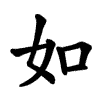如
- to resemble;
- to be like;
- as if;
- such as;
Etymology
Phono-semantic compound or associative compound consisting of:
女 (계집 녀) — representing a person or femininity; sometimes taken as phonetic here.
口 (입 구) — representing speech, communication, or expression.
Two interpretations coexist:
Phono-semantic: 女 (sound) + 口 (meaning “speech”) — to say or act like something.
Associative: both 女 and 口 carry meaning — the woman’s gentle reply or accord in speech, symbolizing agreement, compliance, resemblance.
According to Shuowen Jiezi (說文解字):
「如,从女,从口。言順也。」
“如 consists of 女 and 口; it means harmony in speech or action.”
Originally, 如 implied to follow or act in accordance with, hence the derived sense “to be like, to correspond, to comply.”
Usage in Korean
如同 (여동) — like; as if
如是 (여시) — thus; in this manner
如意 (여의) — as one wishes; satisfactory
不如 (불여) — not equal to; inferior to
譬如 (비여) — for example; metaphorically speaking
猶如 (유여) — just like; similar to
如來 (여래) — Tathāgata; “Thus-Come One” (title of the Buddha)
如前 (여전) — as before; same as previously
倘如 (상여) — if; supposing that
何如 (하여) — how; what about
Words that derived from 如
Additional notes
The nuance of 如 lies between resemblance and accord.
It indicates likeness in appearance or behavior, not identity in nature.
Whereas 同 (same) or 等 (equal) emphasize equality, 如 suggests analogy, conformity, or poetic similarity.
The ancient gloss “다울 여” (to be fitting or seemly) captures this sense: to be as something should be; to act in accordance with its nature.
Thus, 如 connotes both likeness and rightness — to behave “as is proper.”
In literary Chinese, 如 functions as a preposition or conjunction meaning “like,” “according to,” or “if.”
In Buddhist scripture, it frequently appears in philosophical expressions such as:
如來 (Tathāgata) — “Thus-Come One,” meaning the Buddha who arrives as reality is; 如實 (여실) — “as it truly is,” referring to perceiving the world without illusion.
Classical examples:
「恩高如天,德厚似地」
“Grace as high as Heaven, virtue as deep as Earth.”
(Sajaseohak, 四字小學)
Here, 如 expresses resemblance and comparison — “as... like...”.
「百聞不如一見」
“Hearing a hundred times is not as good as seeing once.”
This idiom (originally from Han Feizi) uses 不如 to mean “not equal to, inferior to.”
Cultural and symbolic meaning:
The concept of 如 permeates East Asian philosophy as a symbol of accord with truth or nature.
In Buddhism, “如法” (“according to the Dharma”) and “真如” (“suchness,” tathatā) express the state of reality as it truly is — beyond distinction or illusion.
如 thus bridges the linguistic sense of “like” with the metaphysical sense of “thusness” or “so-ness” — things as they are.
Philosophically, it represents harmony with the Way (道) — to move or speak in accordance with principle, not against it.
Hence, to act 如天 (like Heaven) or 如法 (in accordance with law) means to embody the natural order of things.
From simple comparison (如天, like Heaven) to deep Buddhist metaphysics (如實, as-it-is), 如 carries the enduring idea of acting or being in harmony with truth.
